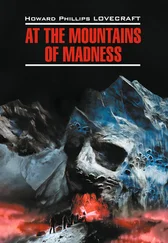Howard Lovecraft - At the Mountains of Madness
Здесь есть возможность читать онлайн «Howard Lovecraft - At the Mountains of Madness» весь текст электронной книги совершенно бесплатно (целиком полную версию без сокращений). В некоторых случаях можно слушать аудио, скачать через торрент в формате fb2 и присутствует краткое содержание. Жанр: Ужасы и Мистика, на английском языке. Описание произведения, (предисловие) а так же отзывы посетителей доступны на портале библиотеки ЛибКат.
- Название:At the Mountains of Madness
- Автор:
- Жанр:
- Год:неизвестен
- ISBN:нет данных
- Рейтинг книги:4 / 5. Голосов: 1
-
Избранное:Добавить в избранное
- Отзывы:
-
Ваша оценка:
- 80
- 1
- 2
- 3
- 4
- 5
At the Mountains of Madness: краткое содержание, описание и аннотация
Предлагаем к чтению аннотацию, описание, краткое содержание или предисловие (зависит от того, что написал сам автор книги «At the Mountains of Madness»). Если вы не нашли необходимую информацию о книге — напишите в комментариях, мы постараемся отыскать её.
At the Mountains of Madness — читать онлайн бесплатно полную книгу (весь текст) целиком
Ниже представлен текст книги, разбитый по страницам. Система сохранения места последней прочитанной страницы, позволяет с удобством читать онлайн бесплатно книгу «At the Mountains of Madness», без необходимости каждый раз заново искать на чём Вы остановились. Поставьте закладку, и сможете в любой момент перейти на страницу, на которой закончили чтение.
Интервал:
Закладка:
Decadent though their style undoubtedly was, these latest carvings had a truly epic quality where they told of the building of the new city in the cavern sea. The Old Ones had gone about it scientifically – quarrying insoluble rocks from the heart of the honeycombed mountains, and employing expert workers from the nearest submarine city to perform the construction according to the best methods. These workers brought with them all that was necessary to establish the new venture – Shoggoth tissue from which to breed stone lifters and subsequent beasts of burden for the cavern city, and other protoplasmic matter to mold into phosphorescent organisms for lighting purposes.
At last a mighty metropolis rose on the bottom of that Stygian sea, its architecture much like that of the city above, and its workmanship displaying relatively little decadence because of the precise mathematical element inherent in building operations. The newly bred Shoggoths grew to enormous size and singular intelligence, and were represented as taking and executing orders with marvelous quickness. They seemed to converse with the Old Ones by mimicking their voices – a sort of musical piping over a wide range, if poor Lake's dissection had indicated aright – and to work more from spoken commands than from hypnotic suggestions as in earlier times. They were, however, kept in admirable control. The phosphorescent organisms supplied light with vast effectiveness, and doubtless atoned for the loss of the familiar polar auroras of the outer-world night.
Art and decoration were pursued, though of course with a certain decadence. The Old Ones seemed to realize this falling off themselves, and in many cases anticipated the policy of Constantine the Great by transplanting especially fine blocks of ancient carving from their land city, just as the emperor, in a similar age of decline, stripped Greece and Asia of their finest art to give his new Byzantine capital greater splendors than its own people could create. That the transfer of sculptured blocks had not been more extensive was doubtless owing to the fact that the land city was not at first wholly abandoned. By the time total abandonment did occur – and it surely must have occurred before the polar Pleistocene was far advanced – the Old Ones had perhaps become satisfied with their decadent art – or had ceased to recognize the superior merit of the older carvings. At any rate, the aeon-silent ruins around us had certainly undergone no wholesale sculptural denudation, though all the best separate statues, like other movables, had been taken away.
The decadent cartouches and dadoes telling this story were, as I have said, the latest we could find in our limited search. They left us with a picture of the Old Ones shuttling back and forth betwixt the land city in summer and the sea-cavern city in winter, and sometimes trading with the sea-bottom cities off the antarctic coast. By this time the ultimate doom of the land city must have been recognized, for the sculptures showed many signs of the cold's malign encroachments. Vegetation was declining, and the terrible snows of the winter no longer melted completely even in midsummer. The saunan livestock were nearly all dead, and the mammals were standing it none too well. To keep on with the work of the upper world it had become necessary to adapt some of the amorphous and curiously cold-resistant Shoggoths to land life – a thing the Old Ones had formerly been reluctant to do. The great river was now lifeless, and the upper sea had lost most of its denizens except the seals and whales. All the birds had flown away, save only the great, grotesque penguins.
What had happened afterward we could only guess. How long had the new sea-cavern city survived? Was it still down there, a stony corpse in eternal blackness? Had the subterranean waters frozen at last? To what fate had the ocean-bottom cities of the outer world been delivered? Had any of the Old Ones shifted north ahead of the creeping ice cap? Existing geology shows no trace of their presence. Had the frightful Mi-Go been still a menace in the outer land world of the north? Could one be sure of what might or might not linger, even to this day, in the lightless and unplumbed abysses of earth's deepest waters? Those things had seemingly been able to withstand any amount of pressure – and men of the sea have fished up curious objects at times. And has the killer-whale theory really explained the savage and mysterious scars on antarctic seals noticed a generation ago by Borchgrevingk?
The specimens found by poor Lake did not enter into these guesses, for their geologic setting proved them to have lived at what must have been a very early date in the land city's history. They were, according to their location, certainly not less than thirty million years old, and we reflected that in their day the sea-cavern city, and indeed the cavern itself, had had no existence. They would have remembered an older scene, with lush Tertiary vegetation everywhere, a younger land city of flourishing arts around them, and a great river sweeping northward along the base of the mighty mountains toward a far-away tropic ocean.
And yet we could not help thinking about these specimens – especially about the eight perfect ones that were missing from Lake's hideously ravaged camp. There was something abnormal about that whole business – the strange things we had tried so hard to lay to somebody's madness – those frightful graves – the amount and nature of the missing material – Gedney – the unearthly toughness of those archaic monstrosities, and the queer vital freaks the sculptures now showed the race to have – Danforth and I had seen a good deal in the last few hours, and were prepared to believe and keep silent about many appalling and incredible secrets of primal nature.
IX
I have said that our study of the decadent sculptures brought about a change in our immediate objective. This, of course, had to do with the chiseled avenues to the black inner world, of whose existence we had not known before, but which we were now eager to find and traverse. From the evident scale of the carvings we deduced that a steeply descending walk of about a mile through either of the neighboring tunnels would bring us to the brink of the dizzy, sunless cliffs about the great abyss; down whose sides paths, improved by the Old Ones, led to the rocky shore of the hidden and nighted ocean. To behold this fabulous gulf in stark reality was a lure which seemed impossible of resistance once we knew of the thing – yet we realized we must begin the quest at once if we expected to include it in our present trip.
It was now 8 P.M., and we did not have enough battery replacements to let our torches burn on forever. We had done so much studying and copying below the glacial level that our battery supply had had at least five hours of nearly continuous use, and despite the special dry cell formula, would obviously be good for only about four more – though by keeping one torch unused, except for especially interesting or difficult places, we might manage to eke out a safe margin beyond that. It would not do to be without a light in these Cyclopean catacombs, hence in order to make the abyss trip we must give up all further mural deciphering. Of course we intended to revisit the place for days and perhaps weeks of intensive study and photography – curiosity having long ago got the better of horror – but just now we must hasten.
Our supply of trail-blazing paper was far from unlimited, and we were reluctant to sacrifice spare notebooks or sketching paper to augment it, but we did let one large notebook go. If worse came to worst we could resort to rock chipping – and of course it would be possible, even in case of really lost direction, to work up to full daylight by one channel or another if granted sufficient time for plentiful trial and error. So at last we set off eagerly in the indicated direction of the nearest tunnel.
Читать дальшеИнтервал:
Закладка:
Похожие книги на «At the Mountains of Madness»
Представляем Вашему вниманию похожие книги на «At the Mountains of Madness» списком для выбора. Мы отобрали схожую по названию и смыслу литературу в надежде предоставить читателям больше вариантов отыскать новые, интересные, ещё непрочитанные произведения.
Обсуждение, отзывы о книге «At the Mountains of Madness» и просто собственные мнения читателей. Оставьте ваши комментарии, напишите, что Вы думаете о произведении, его смысле или главных героях. Укажите что конкретно понравилось, а что нет, и почему Вы так считаете.



